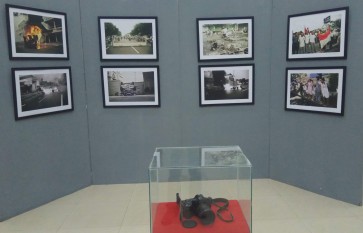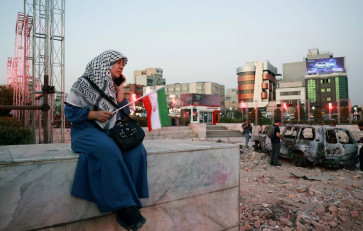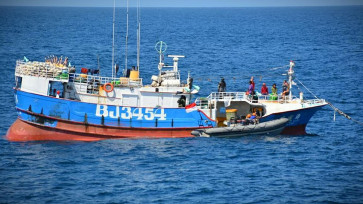Popular Reads
Top Results
Can't find what you're looking for?
View all search resultsPopular Reads
Top Results
Can't find what you're looking for?
View all search resultsExecutive column: Fashion retail is more art than science: Mitra Adi Perkasa CEO
With licenses to market more than 100 global brands from Zara to Reebok, Jakarta-listed PT Mitra Adi Perkasa (MAP) is gearing up for 25 percent growth next year as more Indonesians enter the middle-class
Change text size
Gift Premium Articles
to Anyone

W
ith licenses to market more than 100 global brands from Zara to Reebok, Jakarta-listed PT Mitra Adi Perkasa (MAP) is gearing up for 25 percent growth next year as more Indonesians enter the middle-class. V. P. Sharma, company CEO and self-confessed luxury fashion brand consumer, recently spoke with The Jakarta Post’s Mariel Grazella on the essentials of leading the fashion retail pack.
Question: MAP has an extensive brand portfolio with many of the brands becoming fixtures in the lifestyles of fashionable people. What has been the key to this retailing astuteness?
Answer: Our business is not about big technology or plants for machinery; it is all about the people. We started our company in 1990 and we have a number of very good people who have been working with us for those 22 years. We have dedicated teams managing our business, and they attend all the trade shows in Europe and America, traveling so extensively and keeping an eye open for which brands are emerging, trendy, hot and doing well in a country.
We have a lot of local knowledge because our people have been operating the business for the last 22 years. We know our customers’ profiles, preferences and tastes, including what price points they can afford and what kind of fashion, design and cut they like.
That is how we develop a kind of natural instinct [on fashion], and we depend quite a lot on our instinct, or what we call as our gut feeling.
And how do you win competition from other retailers when it comes to acquiring brand licenses?
It depends from brand to brand but we have to be the front runner by approaching the brand in advance. We have to stay ahead of the game.
For example, when we launched Starbucks about 10 years ago, Starbucks did not even have a regional office in Asia but we had already approached them because we felt that Starbucks had become so relevant and popular in America. It’s the same thing with Zara. No one else had thought of Zara but we had already visited their office.
What has the company learnt about Indonesians’ fashion sensibilities so far? You once said that Indonesians tended to shop first and save money later.
Indonesian customers are very brand conscious. Thanks to the digital media, they know what the latest trends in the world are and they follow those trends. Of course, price points are very sensitive because customers are value conscious. They want the best and latest fashion at affordable prices.
It is very difficult to change the mind-set of the youth. They want to enjoy today and worry about saving tomorrow. This part of our culture and this trend will continue because culture and habits do not change overnight. And if you look at consumer confidence levels, Indonesia has the highest in the world.
You have targeted a strong 30 percent growth for this year. How has business gone so far, and what are the prospects for you, as a retailer, come 2013?
We are focusing on Indonesia. We have a small operation in Thailand but more than 95 percent of our business is here.
There are two big things concerning Indonesia. First of all, looking at the macro economy, GDP growth in Indonesia is 6.5 percent and as much as two-thirds of this GDP comes from domestic consumption. Under this GDP, the middle-class segment, which we are focusing on, is growing very fast. There are 25 million to 27 million people within the middle-class, and this number will double in 2015.
We believe that the middle-class is our direct customer and we are making a huge effort to meet the requirements of people is this bracket. This year, we have already opened 200 shops and our target is to open more than 300 shops within the year, meaning that we have targeted to open over 100 more shops by the end of the year. We are on target so far and I can safely say that we will open more than 300 stores again next year.
The GDP numbers are rosy, but what issues remain thorny for retailers such as MAP?
We are not seeing enough foreign tourists coming to Indonesia.
The biggest costs in retail are rental costs and labor costs, and Indonesia has a competitive advantage because the property and labor costs are inexpensive. A third competitive advantage is service and Indonesians have a natural flair for service.
We have all these competitive advantages but we still do not hear people coming to Jakarta to shop. This, to me, is a kind of challenge because retail is such a big industry that it can stimulate the economy by creating many jobs.
Turning Indonesia into a shopping paradise is more about promotion and marketing, and requires a joint effort from the government and the public sector. This includes the hospitality industry — the hotels and golf courses — to make the Jakarta Big Sale a successful promotion. Singapore has been very good in terms of marketing the Singapore Big Sale and we have not been able to achieve that level.
You have partnered with a slew of foreign brands and have seen these brands make it big in the local market. Drawing lessons of success from these foreign brands, why haven’t local brands been able to make a big splash in foreign markets?
Western brands have dominated the lifestyle segment. These brands, such as Marks and Spencer, are very big in their home market and this allows them to have a lot of resources in terms of design, innovation, research and advertising. It is easier for them to go international because they have deep pockets. If you look at our home market, no brand has become that big.









